In Polen warten moderne Architektur, großartige Museen, ein reiches Tierleben, kulinarische Genüsse und diverse Angebote für Freizeit, Erholung und Kultur für Groß und Klein darauf, entdeckt zu werden. Hier gibt es Inspirationen, um die nächste(n) Reise(n) zu planen.
>> https://www.gov.pl/web/diplomacy/discover-poland
#DiscoverPoland 1 / Architektur
#DiscoverPoland 2 / Musik
#DiscoverPoland 3 / Kunst
#DiscoverPoland 4 / Bühnenkunst
#DiscoverPoland 5 / Natur
#DiscoverPoland 6 / Literatur
#DiscoverPoland 7 / Küche
#DiscoverPoland 8 / Ölindustrie
#DiscoverPoland 9 / UNESCO-Naturerbe Białowieża
#DiscoverPoland 1 / Architektur
Entdeckt Polens spektakuläre und preisgekrönte Architektur!
In den letzten Jahren wurden die urbanen Strukturen des ganzen Landes gründlich modernisiert und weiterentwickelt. Weltweit anerkannte Architekten wie Norman Foster, Helmut Jahn und der in Polen geborene Daniel Liebeskind haben das Warschau von heute gestaltet. Auch einheimische Architekten haben einige der spannendsten modernen Gebäude Europas entworfen.
Im Wortsinne ausgezeichnete Beispiele für herausragende zeitgenössische Projekte sind die Mieczysław-Karłowicz-Philharmonie in Szczecin, das Schlesische Museum in Katowice, das POLIN-Museum für die Geschichte der polnischen Juden in Warschau, das Europäische Solidarność-Zentrum in Gdańsk und das Nationalmuseum in Szczecin, das 2016 beim World Architecture Festival mit dem Titel „World Building of the Year“ ausgezeichnet wurde.
www.spacer.filharmonia.szczecin.pl/en
#DiscoverPoland 2 / Musik
Entdeckt Polens reiches musikalisches Erbe und seine zahlreichen Komponisten von Weltrang!
Wusstet ihr, dass die Polonaise ursprünglich aus Polen stammt? Die Bezeichung „alla polacca“ auf einem Notenblatt zeigt an, dass das Stück mit dem Charakter und Rhythmus dieses Tanzes gespielt werden sollte.
Die traditionelle Musik Polens beruft sich auf Volksweisen, welche für die Aufführungen in Adelshäusern adaptiert wurden und später auf die Konzertbühnen gelangten. Der bekannteste polnische Komponist aller Zeiten Fryderyk Chopin nutzte volkstümliche Melodien aus Polen als Grundlage für seine komplexen Klavierkompositionen. Er brachte die polnische Musik in die Salons der ganzen Welt und richtete ihre Aufmerksamkeit auf sie.
Weitere bedeutende polnische Komponisten waren Stanisław Moniuszko und Ignacy Jan Paderewski sowie die zeitgenössischen Tonsetzer Witold Lutosławski, Henryk Mikołaj Górecki und Krzysztof Penderecki.
www.chopin.nifc.pl/en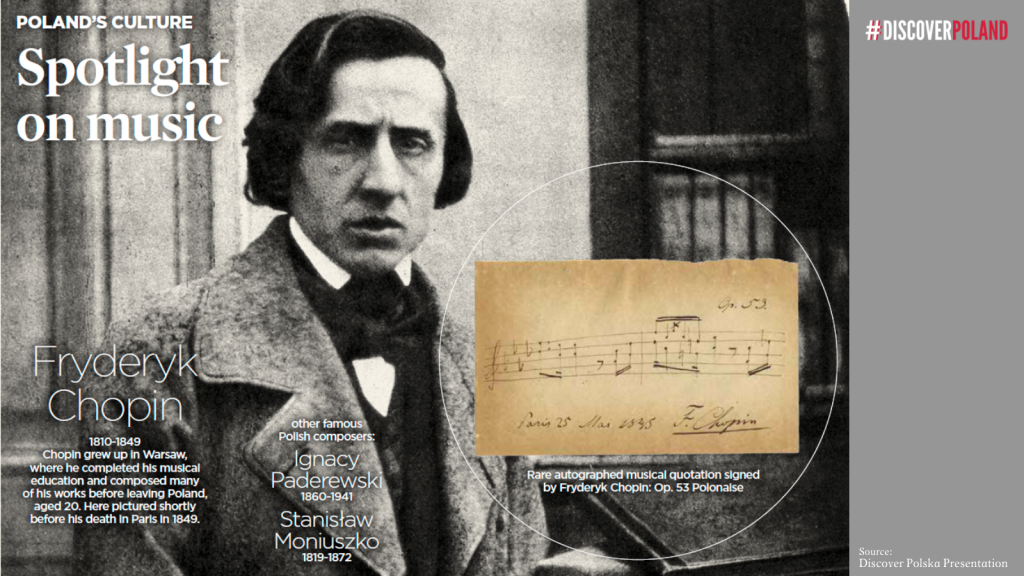
#DiscoverPoland 3 / Kunst
Entdeckt Polens Avantgarde-Künstler/innen und seine quirlige aktuelle Kunstszene!
Künstler/innen wie Władysław Strzemiński, Katarzyna Kobro, Henryk Stażewski und Henryk Berlewi machten Polen zu einem der dynamischsten Kunstzentren im Europa der Zwischenkriegszeit. Nach dem Krieg wurde der Maler und Theaterdirektor Tadeusz Kantor zum Pionier und einer der prominentesten Figuren der künstlerischen Avantgarde in Polen und Europa. Zu den großen Namen der polnischen Gegenwartskunst zählen Zbigniew Libera, Mirosław Bałka, Paweł Althamer, Wilhelm Sasnal, Katarzyna Kozyra und viele andere.
Die Nationalmuseen in Warschau und Kraków sind mit ihren riesigen Sammlungen vormoderner und moderner Kunst ein Muss für alle Kunstliebhaber.
www.zbiory.mnk.pl/en/home-page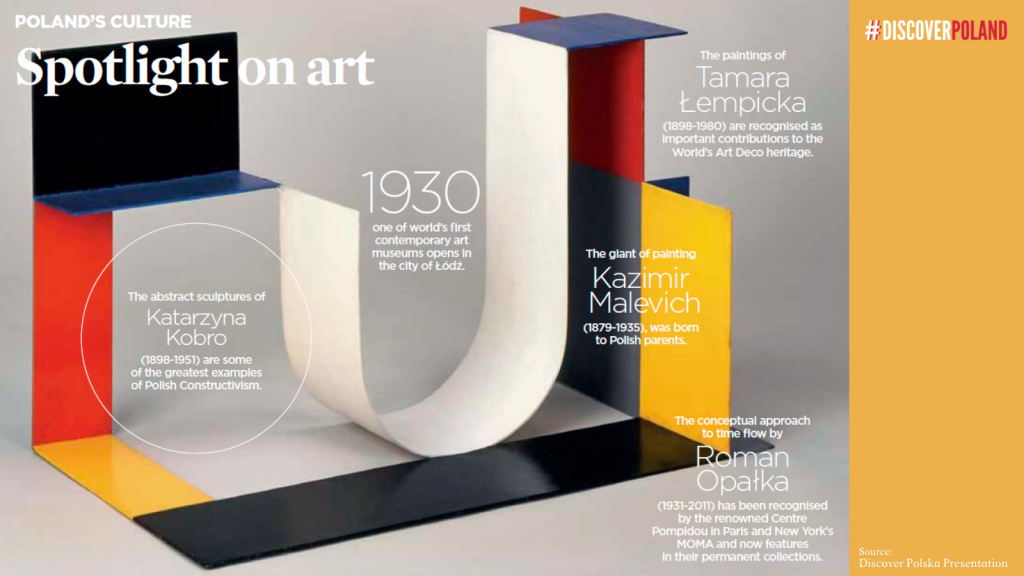
#DiscoverPoland 4 / Bühnenkunst
Entdeckt Polens Opern und Theater, ihre Traditionen und aktuellen Produktionen!
Opern werden in Polen seit dem 17. Jh. aufgeführt und das späte 18. Jh. unter König Stanisław August Poniatowski war ihre Glanzzeit – das Nationaltheater wurde gegründet und die ersten Opern in polnischer Sprache entstanden.
Zu den populärsten Opernkomponisten gehören Wojciech Bogusławski, Józef Elsner, Karol Kurpiński und vor allem der „Vater der polnischen Nationaloper“ Stanisław Moniuszko, neben Fryderyk Chopin der wichtigste polnische Komponist des 19. Jahrhunderts.
Heute ist die Polnische Nationaloper regelmäßig zu Gastspielen im Ausland unterwegs und ihre Aufführungen können rund um den Erdball bewundert werden. Sänger/innen wie Aleksandra Kurzak (Sopran), Piotr Beczała (Tenor) und Jakub Józef Orliński (Countertenor) stehen auf den Bühnen der größten Opernhäuser der Welt von der Metropolitan Opera in New York über das Royal Opera House in London bis hin zur Mailänder Scala.
Wir laden euch ein auf eine virtuelle Tour durch das Große Theater in Warschau, wo Polens Theater, Oper und Ballett ihr Zuause haben!
www.vod.teatrwielki.pl/en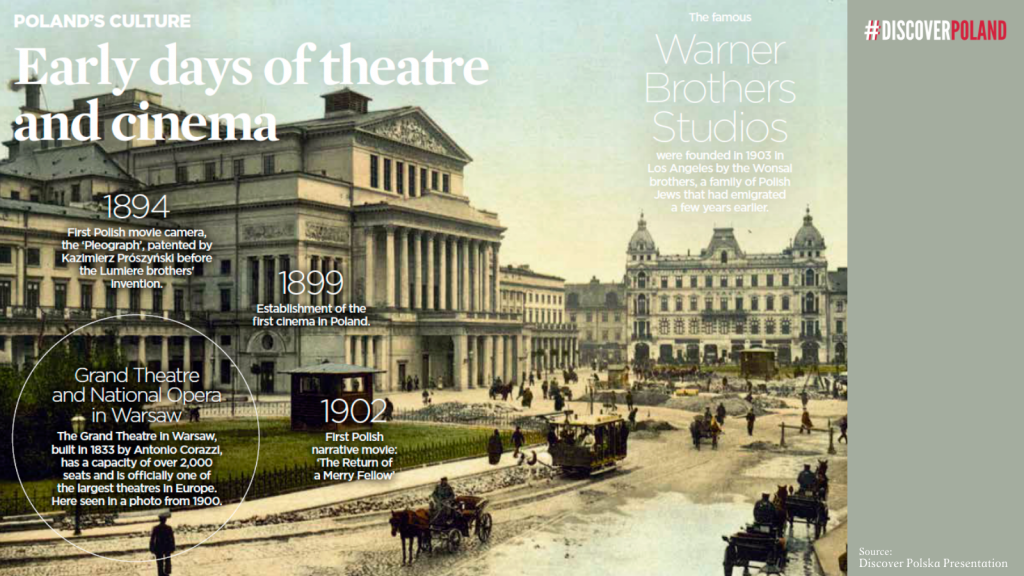
#DiscoverPoland 5 / Natur
Entdeckt Polens reiche Natur und sein vielfältiges Tierleben!
In Polen gibt es 23 Nationalparks, der größte von ihnen ist der Biebrza-Nationalpark im Nordosten des Landes. Er ist mit über 270 Vogelarten (darunter viele seltene Wasser- und Feuchtgebietsvögel) eines von Europas größten Siedlungsgebieten für Wildtiere. 48 Säugetierarten sind hier zu Hause, darunter Polens größte Population von Elchen, und über 1.000 Pflanzenarten.
Die Marschgebiete des Flusses Biebrza sind wichtige Brut- und Raststätten mit ausreichend Nahrung für Vögel. 1995 wurde der Park deshalb als Feuchtgebiet von weltweiter Bedeutung eingestuft und in die Ramsar-Konvention aufgenommen. Auch von BirdLife International wurde der Park als ein Zufluchtsort von globaler Bedeutung deklariert.
Mit mehr als 450 km Fahrradwegen sowie 135 km Kajakrouten, Trekking- und Reitwegen ist der Biebrza-Nationalpark ein Paradies für Vogelfreunde, Outdoor-Freaks und Naturliebhaber. Ihr könnt ihn auch online besuchen!
www.flickr.com/photos/polandmfa/albums/72157649242973640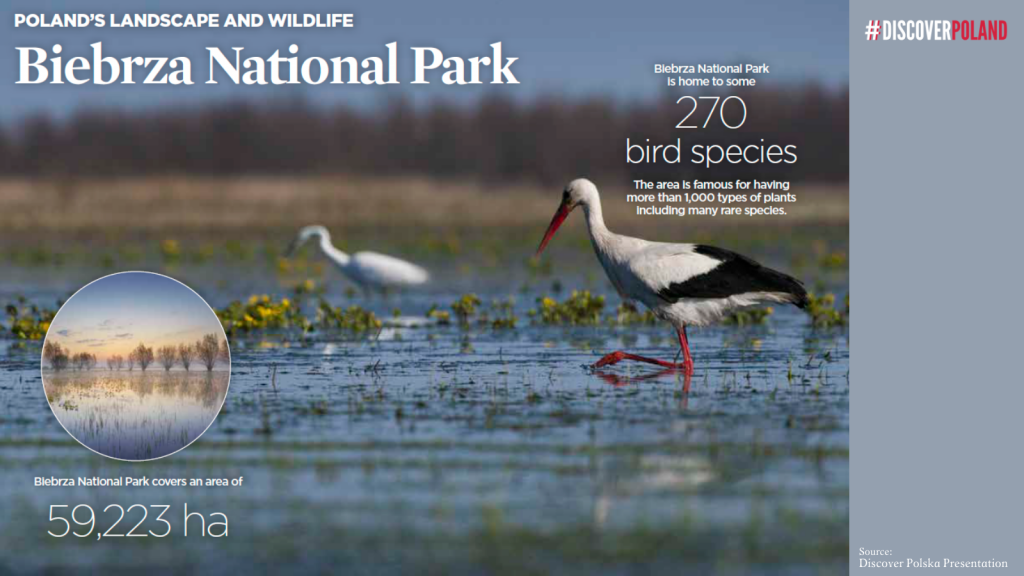
#DiscoverPoland 6 / Literatur
Entdeckt Polens opulente Literatur und seine weltbekannten Autor(inn)en!
Polen hat mit zahlreichen Klassikern einen entscheidenden Beitrag zur Weltliteratur geleistet, darunter „Solaris“, „Das Herz der Finsternis“ und zuletzt Andrzej Sapkowskis Saga über den „Hexer“.
Fünf polnische Autor(inn)en wurden mit dem Nobelpreis für Literatur geehrt: Henryk Sienkiewicz, Władysław Reymont, Czesław Miłosz, Wisława Szymborska und Olga Tokarczuk. Man könnte auch den auf Jiddisch schreibenden polnisch-amerikanischen 🇵🇱🇺🇸 Autor Isaac Bashevis Singer dazu zählen – damit würde Polen auf Rang sechs in der Liste der Länder mit den meisten Literaturnobelpreisträgern liegen.
Auch andere literarische Schwergewichte kommen aus Polen, darunter Józef Teodor Konrad Korzeniowski (besser bekannt als Joseph Conrad), Stanisław Lem und Ryszard Kapuściński.
>> www.mnk.pl/exhibitions/szymborska-drawer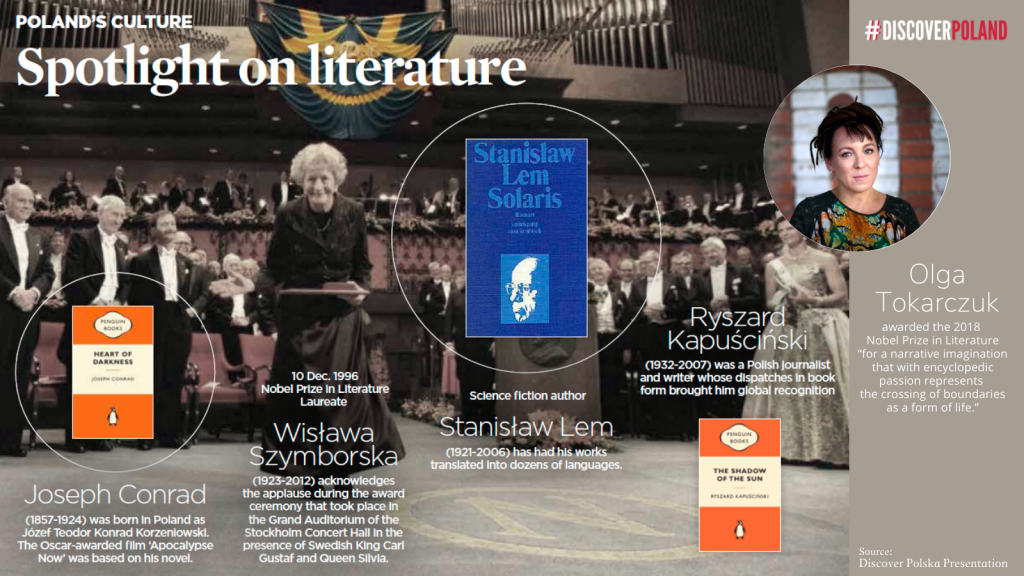
#DiscoverPoland 7 / Küche
Entdeckt Polens schmackhafte Küche und seine regionalen Spezialitäten!
Die polnische Küche ist das Resultat einer Jahrhunderte langen Entwicklung und wurde von der bewegten Geschichte des Landes, seinen zahlreichen Grenzverschiebungen und einem relativ rauen Klima beeinflusst. Diese Zutaten schafften die typisch polnische Mischung slawischer Aromen und internationaler Einflüsse.
Die polnische Landwirtschaft ist ertragreich und liefert in großen Mengen Gerste und Buchweizen. Die endlosen Wälder versorgen die Einwohner körbeweise mit Beeren, Kräutern, Pilzen und Honig, welche regelmäßig den Weg auf polnische Esstische finden. Die traditionelle polnische Küche ist berühmt für ihre unverwechselbaren Suppen, gefüllte Piroggen, Jägereintopf sowie Wild- und Fischgerichte.
Das Land verfügt insgesamt über 43 EU-geschützte regionale Spezialitäten. Dazu gehören diverse Käse- und Wurstsorten, Gebäck, Honig und spezielle Bohnen-, Apfel- und Erdbeersorten.
>> www.issuu.com/msz.gov.pl/docs/polish_culinary_paths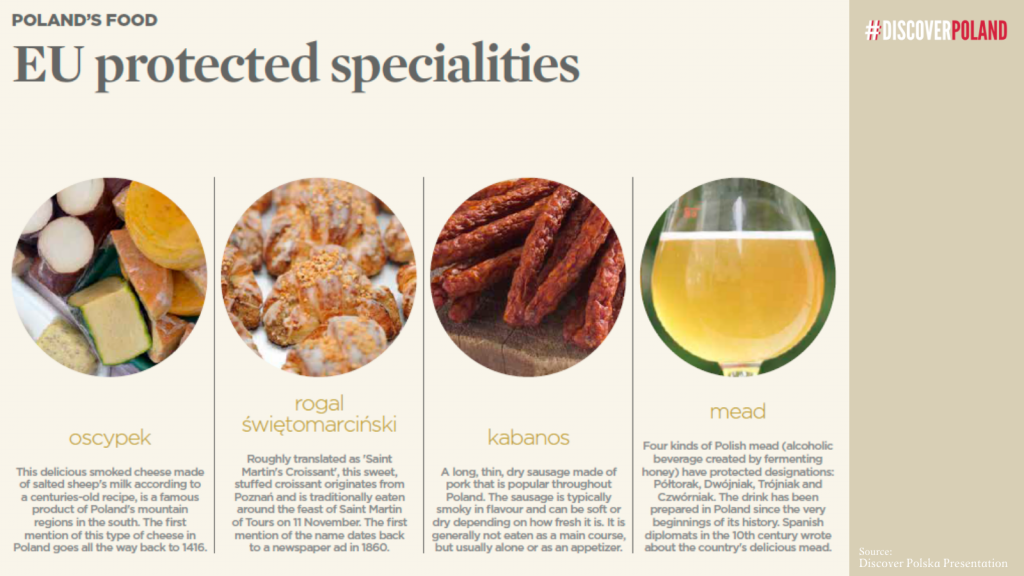
#DiscoverPoland 8 / Ölindustrie
Entdeckt Polens revolutionäre Erfindungen und die Anfänge der Ölindustrie!
Wusstet ihr, dass die erste Fördereinrichtung und Raffinerie für Rohöl in Polen errichtet wurden? 1854 wurden sie in Bóbrka in der Nähe von Krosno eröffnet. Initiator war der Pharmazeut und Chemiker Ignacy Łukaszewicz, der bei der Destillation und Verwendung von Rohöl Pionierarbeit leistete. Łukaszewicz erfand die Kerosinlampe, welche 1853 erstmals das Fenster seiner Apotheke in Lwów (Lemberg) erleuchtete. Diese Lampe spendete er dem OP-Saal im örtlichen Krankenhaus, damit bei Notfällen auch nachts Operationen durchgeführt werden konnten. Der 31. Juli 1853, als der erste nächtliche Eingriff stattfand, gilt somit als Beginn der Öl- und Gasindustrie nicht nur in Polen, sondern weltweit.
Die Lampe, welche acht bis zehn Wachskerzen ersetzte, revolutionierte schnell die Technologie künstlicher Beleuchtungen und setzte sich in einem reichlichen Jahrzehnt auf der ganzen Welt durch.
Zu Beginn des 20. Jh. stand Polen unter den Petroleum-Produzenten weltweit an dritter Stelle nach den USA und Russland.
Die Ölfördereinrichtung in Bóbrka ist bis heute in Betrieb und das große Gebäude, von dem aus Łukaszewicz sein Öl-Imperium dirigierte, beherbergt heute ein Museum für die Gas- und Ölindustrie.
>> www.bobrka.pl/en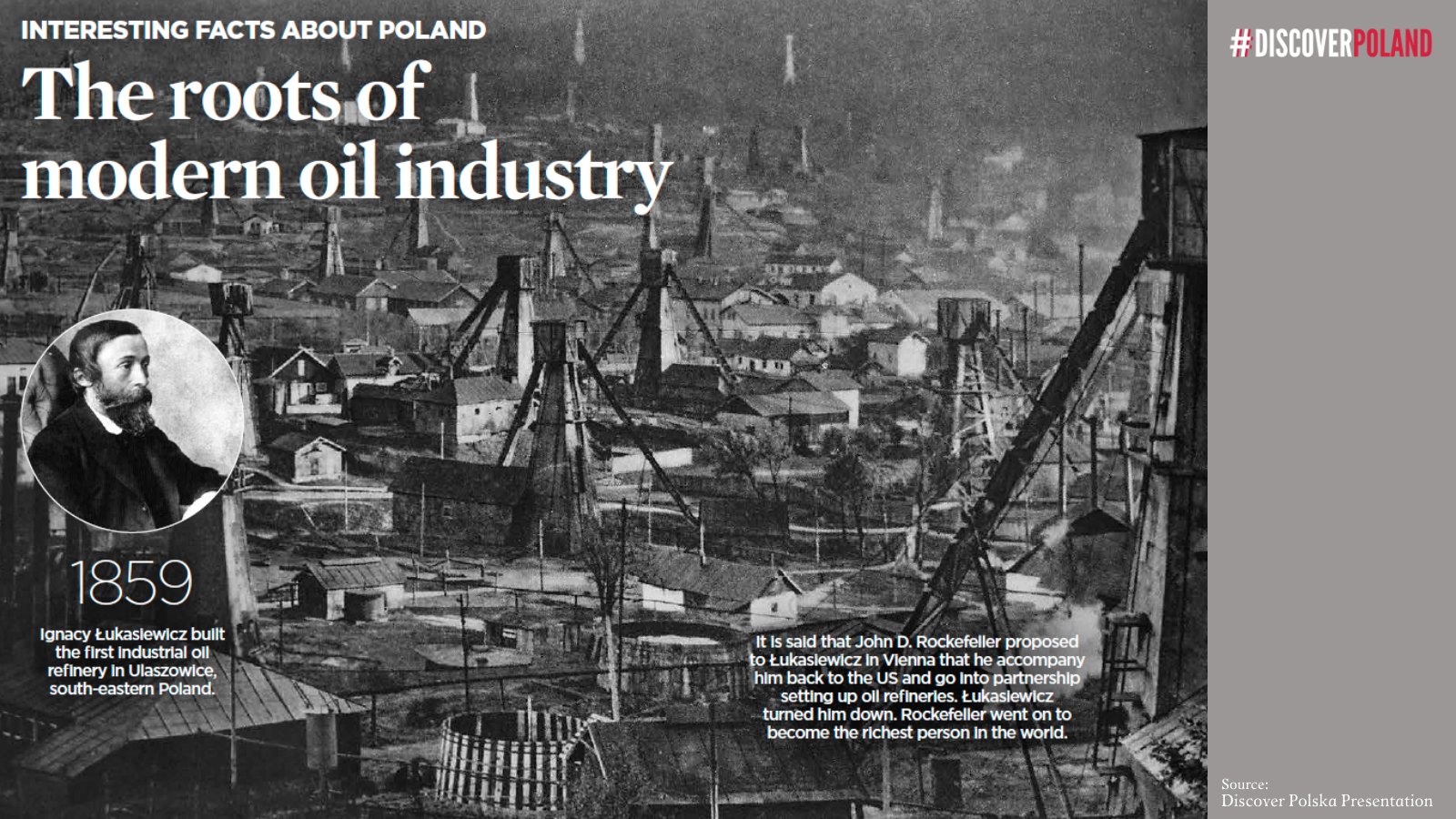
#DiscoverPoland 9 / UNESCO-Naturerbe Białowieża
Entdeckt Polens Kultur- und Naturerbe auf der Liste der UNESCO!
In Polen gibt es derzeit 16 UNESCO-Welterbestätten, von denen 15 – darunter die Marienburg in Malbork und die historischen Innenstädte von Kraków, Toruń, Warschau und Zamość zum Kulturerbe zählen und eine Stätte zum Naturerbe: der Urwald von Białowieża.
Dieser Urwald liegt an der Grenze von Polen und Belarus und ist ein letztes Überbleibsel des Urwalds, der sich einst quer durch ganz Europa erstreckte, von der Atlantikküste bis zum Ural. Große Teile blieben Jahrhunderte lang unberührt, so dass sich dort eine außergewöhnliche Flora und Fauna ansiedeln konnten. 25 % der europäischen Wisent-Population – Europas größtes Säugetier – leben hier und viele weitere bedrohte Arten.
In der heraufziehenden Sommerhitze ist das Salzbergwerk von Wieliczka nahe Kraków eine der coolsten UNESCO-Welterbestätten: Man kann 820 Stufen hinab steigen und taucht in eine Welt, wo konstant 14–16 °C herrschen. Die Mine, die 1978 auf die Liste gesetzt wurde, ist ein Labyrinth aus Tunneln und Kammern, welche in das Steinsalz gemeißelt wurden. Ihre Geschichte reicht bis in das 13. Jahrhundert zurück.
>>www.ai360.pl/panoramy/279
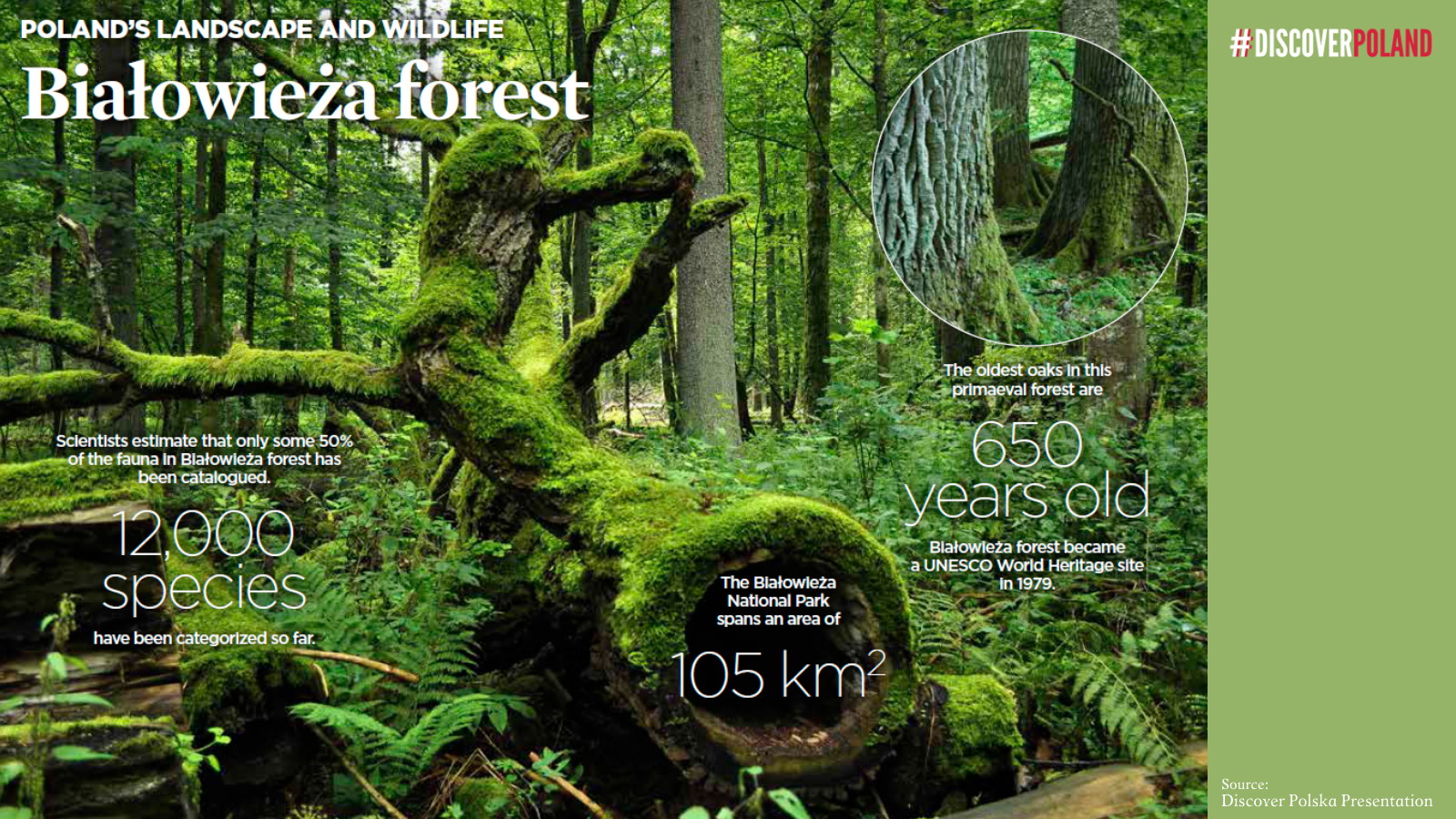
Information in English 🇬🇧:
The geometrical center of Europe is located near Poland’s capital, Warsaw. Throughout its history, Poland has gone from a major European power, through lost independence to re-emergence as a regional economic pioneer of Central and Eastern Europe. Polish enthusiasm, creativity and entrepreneurship are widely known across the world today. Thanks to our determination, Solidarity, and the spiritual guidance of Saint Pope John Paul II, after almost 50 years of communism, Poland broke free from foreign political control and economic influence, and set on a path to freedom in 1989. It is now a country whose rich customs and traditions attract millions of tourists from all over the world.
Arts and culture have for centuries been strengthening the Polish national identity and helped Poles survive the worst moments in history. Polish musicians have and continue to inspire the world. Poland is the birthplace of one of the greatest composers and pianists Fryderyk Chopin, and one of the world’s most important music competitions dedicated to his music – The Fryderyk Chopin International Piano Competition has been held in Warsaw every five years since 1927. Other famous composers include Stanisław Moniuszko, Ignacy Paderewski, Witold Lutosławski, Mikołaj Górecki and Krzysztof Penderecki, a four-time Grammy Award winner. Explore Penderecki’s Digital Garden inspired by his music! Stanisław Moniuszko, who whose 200th birth anniversary was celebrated in 2019, is considered the father of Polish opera. Nowadays Performances by the Polish National Opera are staged worldwide while Polish singers such as Aleksandra Kurzak, Piotr Beczała and Jakub Józef Orliński perform in the world’s major opera houses, from New York’s Metropolitan Opera through London’s Royal Opera House to Milan’s La Scala.
Poland is home to Nobel Prize laureates and Oscar winners. Thanks to the winners of the Nobel Prize for Literature, Henryk Sienkiewicz, Władysław Reymont, Czesław Miłosz, Wisława Szymborska and Olga Tokarczuk, Poland has been enjoying a reputation as the land of poets and writers. Joseph Conrad, Stanisław Lem and Ryszard Kapuściński also made their names abroad. The Polish language, which is actively used by about 50 million people and by at least 10 million who have a passive knowledge of it, is an important element of the Polish literary tradition.
Polish was the language of Andrzej Wajda’s films, for which he received prestigious awards, including the Honorary Oscar for his lifetime achievements. Polish filmmakers excel at home but also make an impact abroad. Internationally recognized Polish film directors include Krzysztof Kieślowski, Agnieszka Holland, Roman Polański and Paweł Pawlikowski awarded an Oscar for “Ida” in 2015. Poland is also renowned for its numerous directors of photography who were involved in the making of some of Hollywood’s top productions. An important place for Polish cinema is the internationally recognized National Film, Television and Theatre School in Łódź, which produced some of Poland’s greatest cinematographic talents.
In the pre-war period, Poland was one of the most dynamic centres of avant-garde art in Europe, with artists such as Władysław Strzemiński, Katarzyna Kobro, Henryk Stażewski and Henryk Berlewi. After the second world war, one of the first artists of the new avant-garde was the internationally acclaimed painter and theatre director Tadeusz Kantor. Today, big Polish names in the contemporary art market include Zbigniew Libera, Mirosław Bałka, Paweł Althamer, Wilhelm Sasnal, Katarzyna Kozyra and others. The richest collection of Polish avant-garde art is in the National Museums in Warsaw and Kraków.
Posters of the Polish School of Posters significantly influenced the international development of graphic design in poster art. Their major contribution is due to their use of the power of suggestion through clever allusions. Using strong and vivid colors typical for folk art, they combine printed slogans, often hand-lettered, with popular symbols, to create a concise inventive metaphor. Prominent contributors included Henryk Tomaszewski, Jan Lenica, Jan Młodożeniec and Waldemar Świeży. The Poster Museum in Warsaw houses the largest collection of art posters in the world.
Poland is a country of people with ideas. Poles take pride in their scientists whose important discoveries and inventions changed the world. Nicolaus Copernicus (1473-1543), the famous astronomer, who formulated the heliocentric theory, according to which the Earth revolves around the Sun, and not the other way round, was born in Toruń. Maria Skłodowska-Curie, a native of Warsaw, is considered to have been the most important researcher of all time, and has remained until this day the only woman to have been awarded the Nobel Prize twice (in 1903 and 1911), and the only scientist honored in two separate fields of science. She was the first woman to receive a Nobel Prize for chemistry, for having discovered polonium and radium, the first woman to have been appointed professor at the Sorbonne University of Paris, and the first woman to have been honoured a full member of the French Medical Academy. Jan Czochralski, a Polish physicist, invented the method of growing single-crystals, which proved to be the basis of modern electronics. Single-crystal silicon obtained through this method helped create semiconductor devices. Thanks to them, we do our work using computers, tablets, mobile phones, digital cameras, mp3 players and other electronic devices. The first crude oil mine worldwide was opened in Poland. It was established in 1854 by Ignacy Łukasiewicz, pharmacist and chemist, in Bóbrka near Krosno. A year before, Łukasiewicz gave a hospital in Lviv a prototype paraffin lamp he had developed to assist with emergency surgeries. This is thought to be the first case of an oil-based product being sold. The mine is still in operation, and within its premises there is a monumental administrative building from which Łukasiewicz managed the process of oil extraction, as well as a Museum of the Oil and Gas Industry. Three brilliant Polish mathematicians Marian Rejewski, Jerzy Różycki and Henryk Zygalski broke the codes of the Enigma, the most infamous German cipher machine, thus contributing to Allied victory in World War II.
Located between the Baltic Sea and the Masurian lake district in the north and the mountain ranges in the south, with extensive lowlands in the centre, Poland is an great tourist destination. Boasting 23 national parks, 145 landscape parks and 1,500 nature reserves, Poland is a perfect spot for active recreation, including hiking, cycling, rafting, river and lake canoeing, sailing, surfing and horse-riding. It also makes for a great place to observe rare species of birds in their natural habitat.
For those who love traditional food, Poland offers a huge variety of products to delight their palate. The country has a total of 43 regional specialties which are protected under EU law. The list includes several varieties of cheese and sausage, as well as regional pastries, specially grown beans, honeys, apples and strawberries. Thanks to regional variations and specialties, as well as the heritage of its nobility, Poland has a rich food culture. In the south, where the climate is rougher, the food is based on simple, filling dishes. In Małopolska, you can feel the Austrian influence, and in Podlasie – culinary traditions and flavours from its eastern neighbours. Thanks to the access to the sea, northern Poland is rich in fish dishes of many different forms. Mazowsze, with Warsaw at its heart, is known for its Old Polish cuisine.
Poland has several large cities which are the economic backbone of the country. They are a diverse set with varying histories, but they all offer a wide array of business opportunities and cultural activities. Take for instance Wrocław, referred to sometimes as the Venice of the north, Szczecin, or Paris on the Oder, Zamość, which was established almost 500 years ago, Krakow, Łódź – the city of film, and Katowice – the city of music.
Poland boasts 17 objects on the UNESCO World Remembrance List. Each of the documents and collections is a separate chapter in the history of Poland. For example, the the famous 21 Gdańsk Demands written on wooden plywood. Symbolically, it is the most important “document” from the August 1980 events that played a huge part not only for regaining freedom in Poland, but also on an international scale: as part of the process of overthrowing communism throughout Central and Eastern Europe.
Poland has also sixteen unique places on the UNESCO World Cultural and Natural Heritage List. The first sites – Kraków and Wieliczka – were included in 1978, and the newest site – Krzemionki Prehistoric Striped Flint Mining Region – in 2019.
Tourists are attracted to Poland by countless cultural events that include festivals of music, film and theater and hosted by Polish cities, some of them famous for their award winning architecture. Like the beautiful M. Karłowicz’s Philharmonic in Szczecin, awarded the prestigious 2015 Mies van der Rohe Award, or the National Museum in Szczecin – the Dialogue Centre Upheavals, which was named the World Building of the Year in 2016 at the World Architecture Festival in Berlin. Other outstanding public buildings representing world-class architecture in Poland include the Shakespearean Theatre, the European Solidarity Centre and the Museum of World War II, all three in Gdańsk, the Silesian Museum in Katowice built on the site of a former coal mine, the seat of the Polish National Radio Symphony Orchestra in Katowice, and the Krzysztof Penderecki European Centre for Music in Lusławice, Cricoteca (Tadeusz Kantor Museum) in Krakow, the Warsaw Rising Museum and the POLIN Museum of the History of Polish Jews in Warsaw.
Visiting these unique cultural landmarks gives an insight into the complex history of Poland and at times into the tragic fate of its people, especially related to the experience of World War II. Poland has been the guardian of memory, protecting the Jewish heritage lost during World War II by supporting the development of the contemporary culture of the Jewish minority in Poland. A flagging example of that support is, among others, the Jewish Culture Festival in Krakow which, for more than 30 years, has been the most spectacular interdisciplinary festival of its kind in the world and is visited every year by tens of thousands of tourists.
Poland also attracts music lovers, theater-goers and film buffs. It is a real treat meeting the greatest contemporary music creators and best musicians during the Warsaw Autumn International Festival of Contemporary Music, Wratislavia Cantans, Chopin and his Europe, Actus Humanus or Sacrum Profanum. You can meet movie stars and world-renowned cinematographers at the EnergaCAMERIMAGE festival in Toruń, or independent artists from all around during the New Horizons International Film Festival in Wrocław, which presents artistic, visionary and experimental cinema. And there are many more interesting festivals held in Poland.
Poland welcomes the youngest visitors with many attractions. European Fairytale Capital is in Pacanów, Poland! The modern facility resembling sand pies is a magic place where you can meet the Little Prince, see the pea that meant a sleepless night, and set off on a journey by train which goes through the Mouse Hole and … flies into space! Apart from Polish fairytale heroes like Matołek the Billy-goat, who discovered a Fairytale Land in Pacanów, children may enjoy the Bedtime Cartoons Museum in Rzeszów and watch Polish animation for children. Poles love science centers which allow youngsters experience science through experiment. There are several across Poland like: Copernicus Science Center in Warsaw, Science and Technology Centre EC1 in Lodz, Experyment Science Centre in Gdynia, Hewelianum Center in Gdańsk, Mill of Knowledge Innovation Center in Torun, Garden of Experiments in Cracow or Water Knowledge Center Hydropolis in Wrocław.
(Republic of Poland – Ministry of Foreign Affairs)

